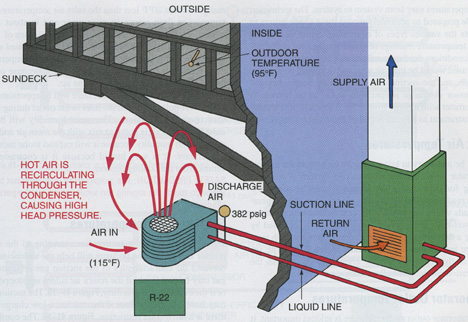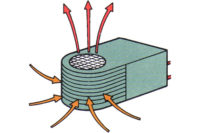The dispatcher calls Bob and gives him a service call at a residence. The house is getting hot because the unit is not cooling even though it has been running. It is a 4-ton system.
The weather is really hot when Bob arrives, 96 degrees F. He pulls his truck to the back of the driveway to prevent blocking the homeowners' cars. Bob is familiar with the system. He goes to the front door and the wife comes to the door. She invites him in to check out the system. It is hot in the house. The thermostat's thermometer registers 84 degrees F. She tells Bob that the system had been working until it got really hot. He could hear the indoor fan running, but the air coming out of the registers is room temperature, not cold.
Bob goes out back to the outdoor unit and finds the problem quickly. The homeowners had added an extension to the wooden deck in the back of the house and the unit is now under the deck. He could hear the condenser fan running, but could not hear the compressor. Bob goes into the house and turns the unit off to let it cool down. He then asks the owner when the deck had been added on. She says that it was finished three days ago.

She responds, "Yes, but they said that it would be OK because there was plenty of room to work on the unit."
Bob then says, "I think the deck is the problem. There is only about two feet of clearance above the unit and the fan discharge is upward. Hot air must be hitting the deck and recirculating back into the unit. This would cause the compressor to overload and shut off (Figure 1). I will go to the unit and see what I can do."
She replies, "We are having a party here tomorrow night and we just have to have cooling. It is a very important business party."
Bob goes down to the unit. Sure enough, the deck is about 18 inches above the fan discharge. This would never work.
Btu Buddy then appears and asks, "What is the problem, Bob?"
Bob explains what is going on. Either the deck or the unit must be moved. There is a party tomorrow night and the company doesn't have time to move the unit. "I have to have another plan."

Bob shuts off the electrical disconnect and locks it, then connects the water hose to cool the compressor (Figure 2).
Btu Buddy then says, "Call the shop and have them send out one of those large prop-type fans and we can set it under here to move air over the condenser until we can work up a plan. Those fans move a lot of air and are not very loud."
Bob makes the call and has the fan coming over. The compressor is cooling down and the fan is expected within a half hour.
Btu Buddy suggests, "Talk to the owner and tell her that the condenser must be moved and you cannot do it until next week, but that you can provide cooling with a temporary rig until then. She may want to have her husband look at what is happening."
Bob talks to her and she calls her husband who will come home in a few minutes.
Btu Buddy says, "Let's look at an alternative location for the condensing unit."

Relocating The Condensing Unit
Bob and Btu Buddy walk around the back of the house close to the deck looking for a good spot for the condenser. It looks like it should be moved to the end of the house and around the corner. Btu Buddy says, "That looks like a good place, but it is by the master bedroom and there are windows close by. I think you would get noise complaints if we moved it there."The husband gets home about that time and gets into the conversation. He suggests a particular spot that he likes.
Bob looks up and sees that there is a drain right over that spot and says, "This place is really not suitable for the unit because an excess of water could run into the unit (Figure 3)."
The husband then asks, "Aren't they rainproof?"
Bob says, "Yes, but there are times when there will be large volumes of water coming down between these two roofs and pouring into the unit. It is not made to take that much water."
They keep looking around and decide to move the unit to the far end of the deck, next to the driveway. It is about 25 feet to the new location, but the piping and the electrical can be run under the house. It is actually closer to the electrical panel so the electrical run will be much closer.
The fan arrives and Bob removes the water from the compressor and replaces the compressor compartment cover. He goes into the house and sets the thermostat to cooling. He then turns on the large fan about five feet from the condensing unit. He turns the disconnect to the unit back on. The compressor and fan start. Bob feels the compressor suction line and notices that it is getting cool. The unit seems to have a charge of refrigerant in it. That looks good.
Bob asks the husband to come out to the unit so he can show him what is happening. Bob turns off the fan for a few minutes and the heat under the deck begins to build up. The husband says, "Wow, I would not have believed it could get this hot this quick."
Bob restarts the fan and the heat dissipates. The system will be OK as long as the fan is running.
Bob then tells the homeowners, "I will talk to the foreman and get him to get you a price on moving the unit."
The husband says, "Just come and do it. I have worked with you and your company long enough to know that you will be fair. Thanks for the thoughtful service."
While riding away, Btu Buddy says, "Another satisfied customer. It is much easier to keep a good customer than to go and find another one. You are really improving your people skills as well as your technical skills."
Bob says, "Thanks, it is sometimes hard to be nice to customers, since they are often hot and bothered when we get there. That can make them a little difficult to deal with."
Bill Johnson has been active in the HVACR industry since the 1950s. He graduated in gas fuel technology and refrigeration from the Southern Technical Institute, a branch of Georgia Tech (now known as Southern Polytechnic Institute). He taught HVAC classes at Coosa Valley Vocational & Technical Institute for four years. He moved on to become service manager for Layne Trane, Charlotte, N.C. He taught for 15 years at Central Piedmont Community College, part of this time as program director. He had his own business for five years doing installation and service work. Now retired, he is the author of Practical Heating Technology and Practical Cooling Technology, and continues as a co-author of Refrigeration & Air Conditioning Technology, 5th Edition, all published by Delmar Publishers. For more information, he can be reached at 704-553-0087, 704-643-3928 (fax), or billj@carolina.rr.com.
Publication date: 08/22/2005





